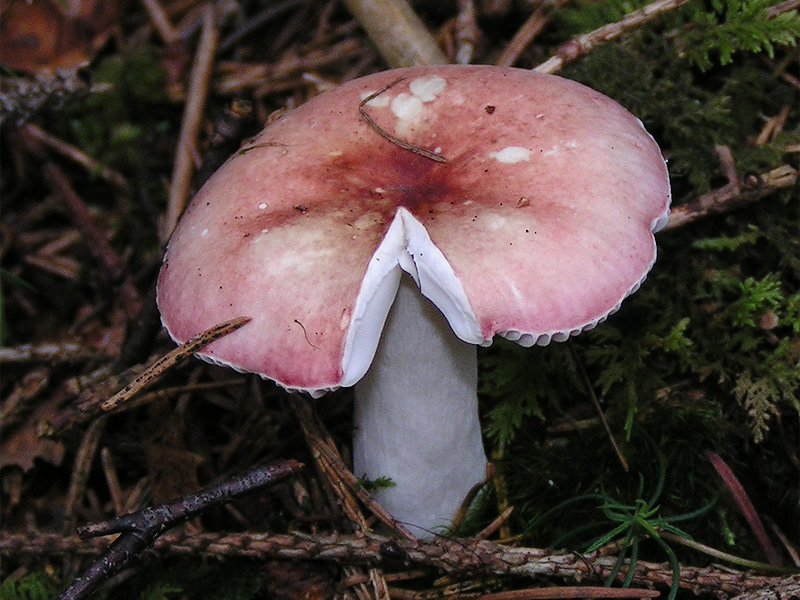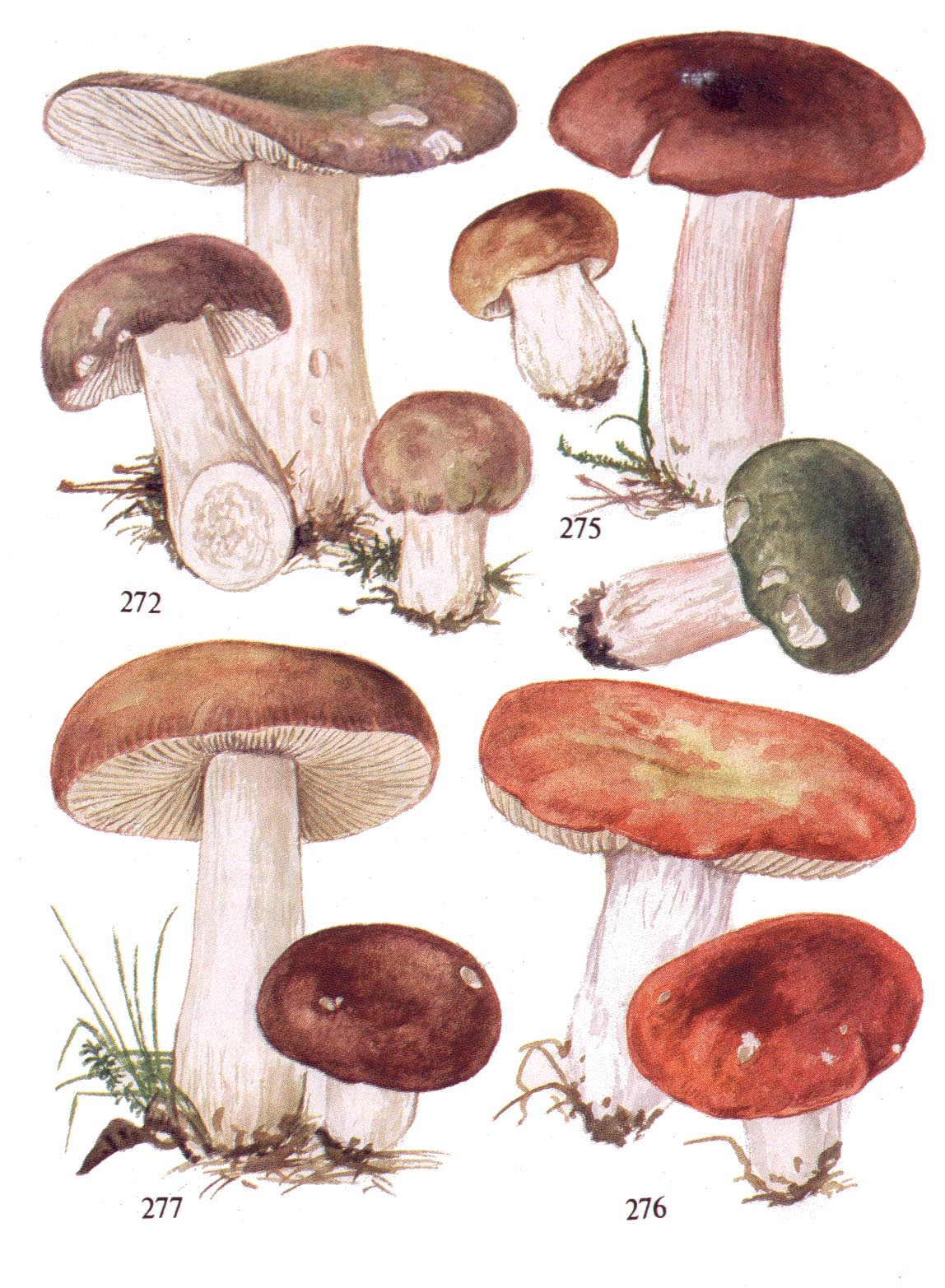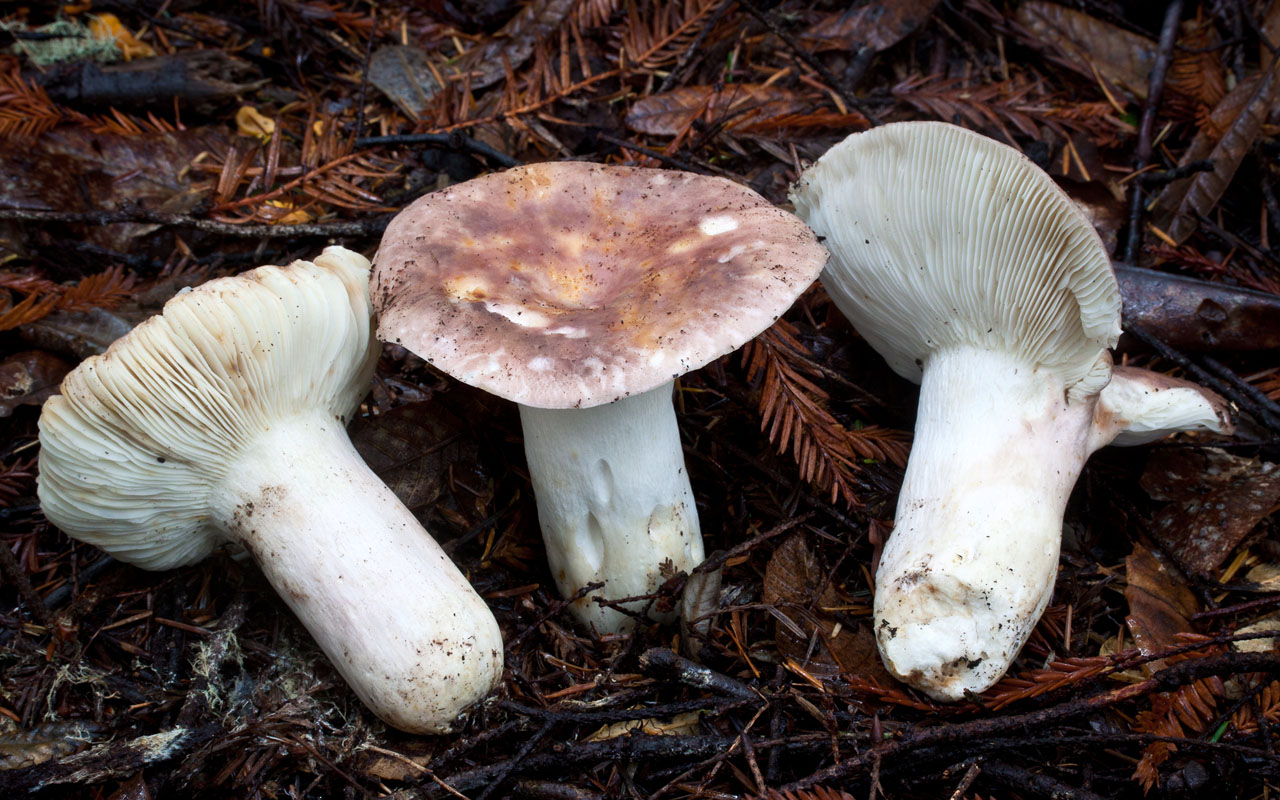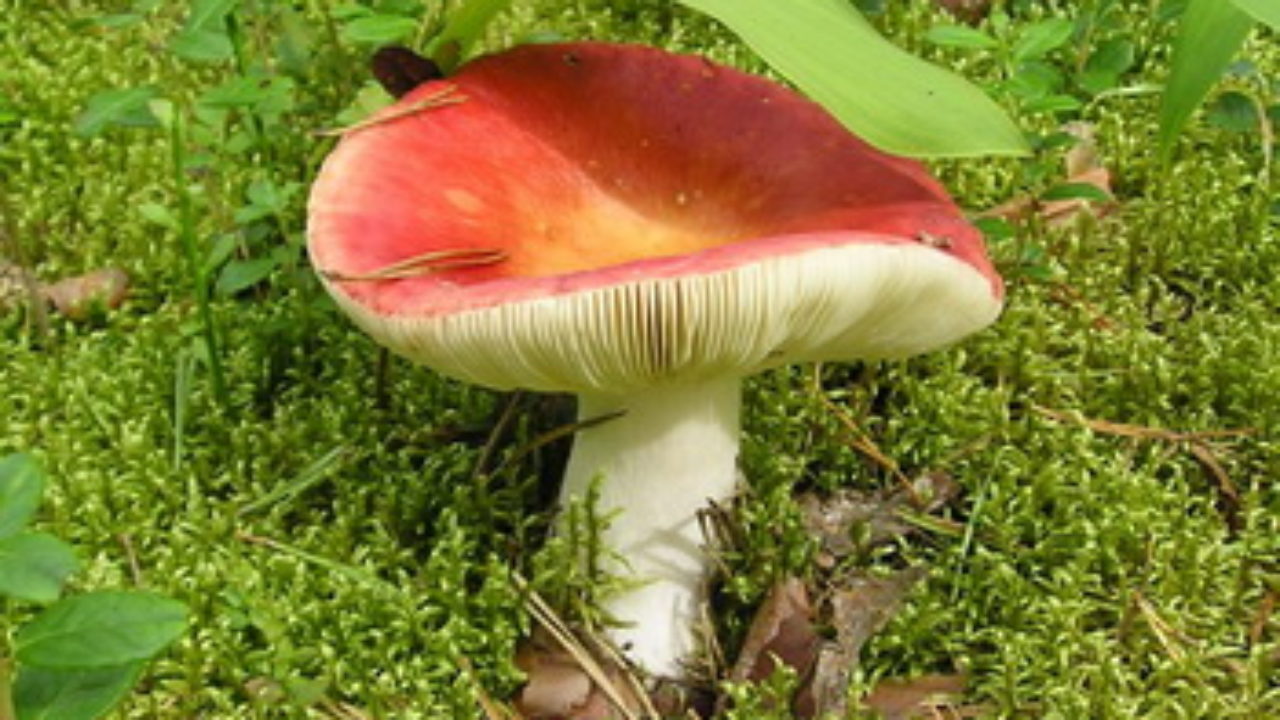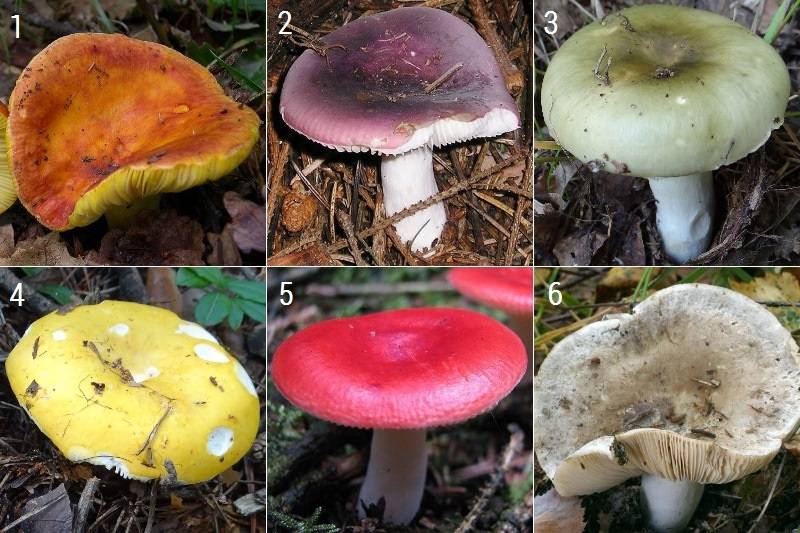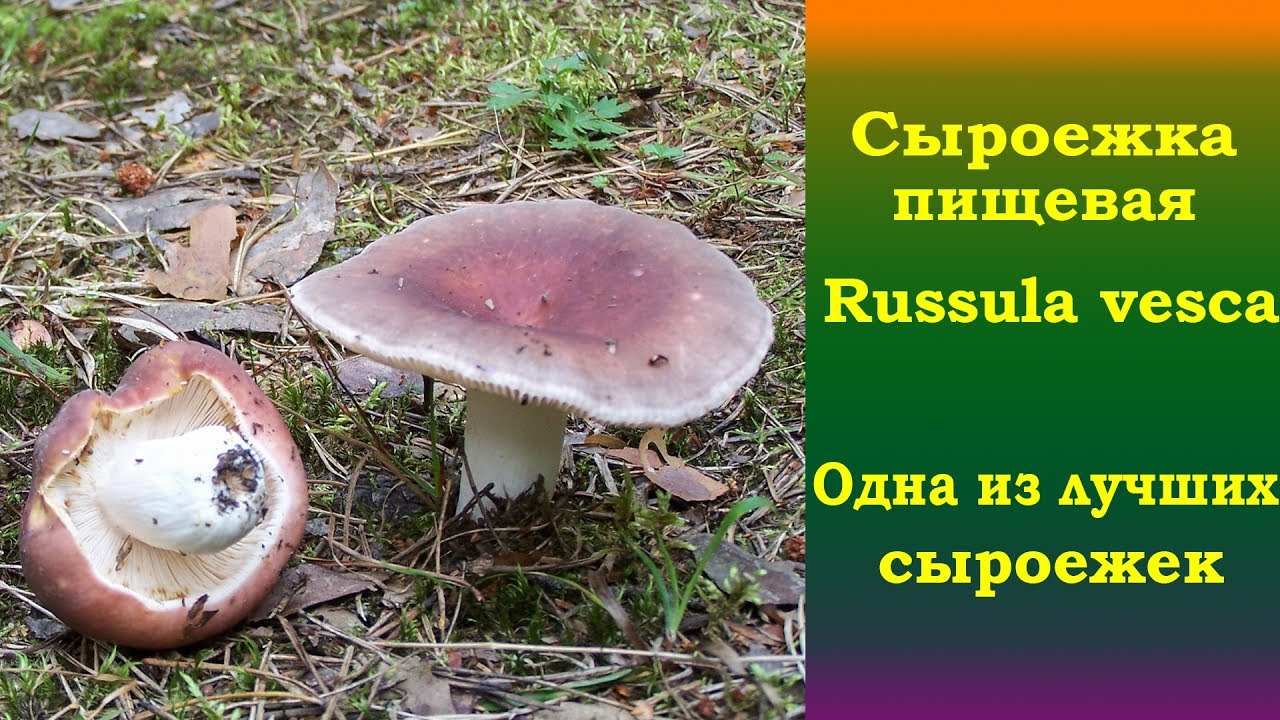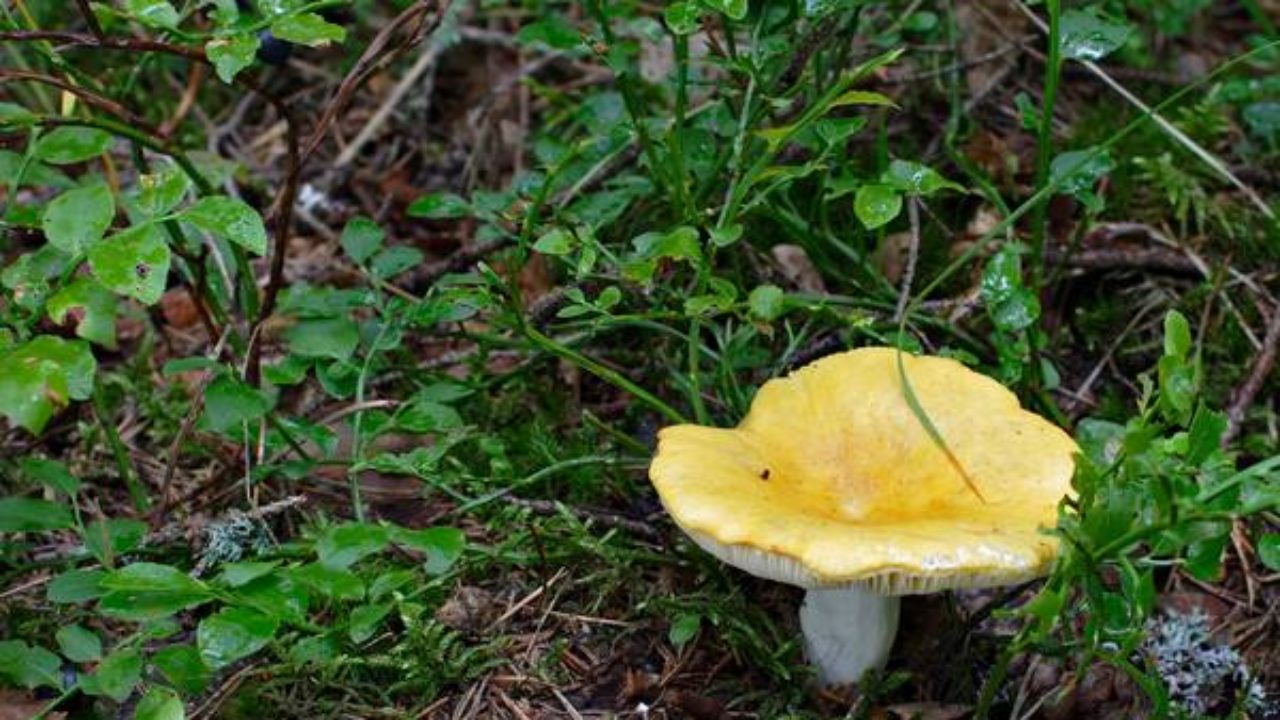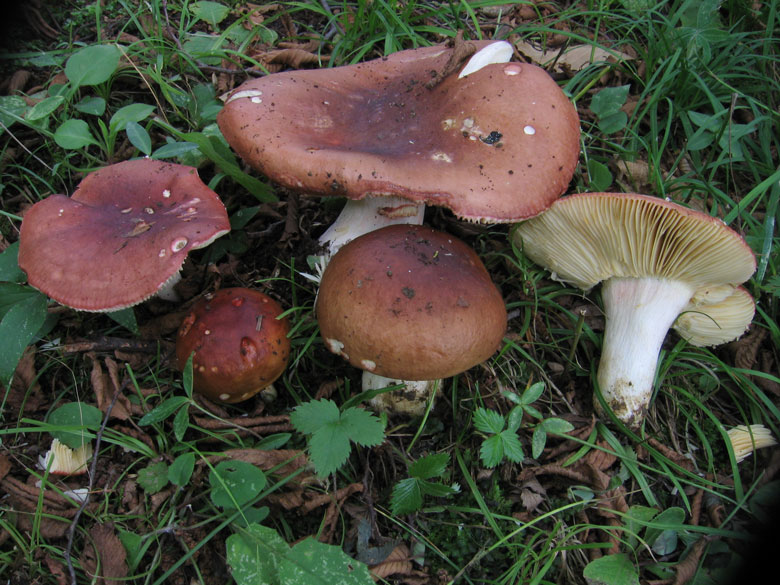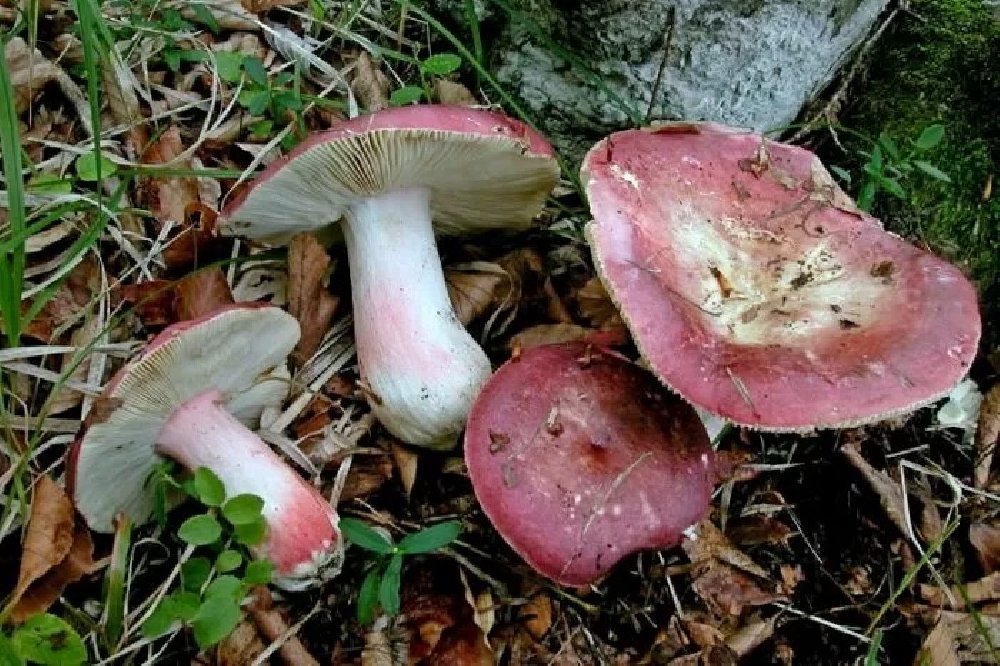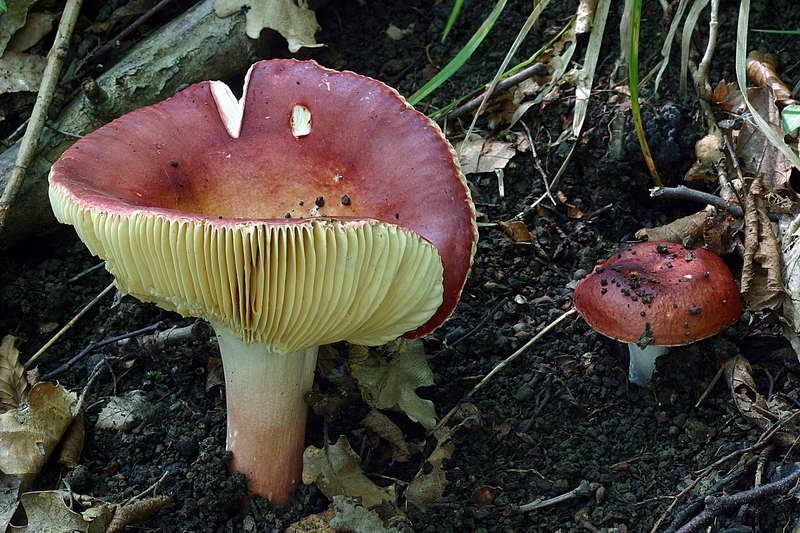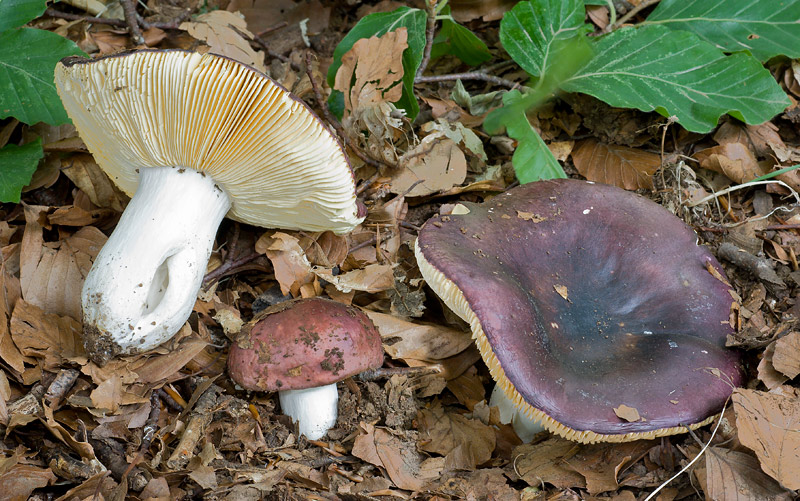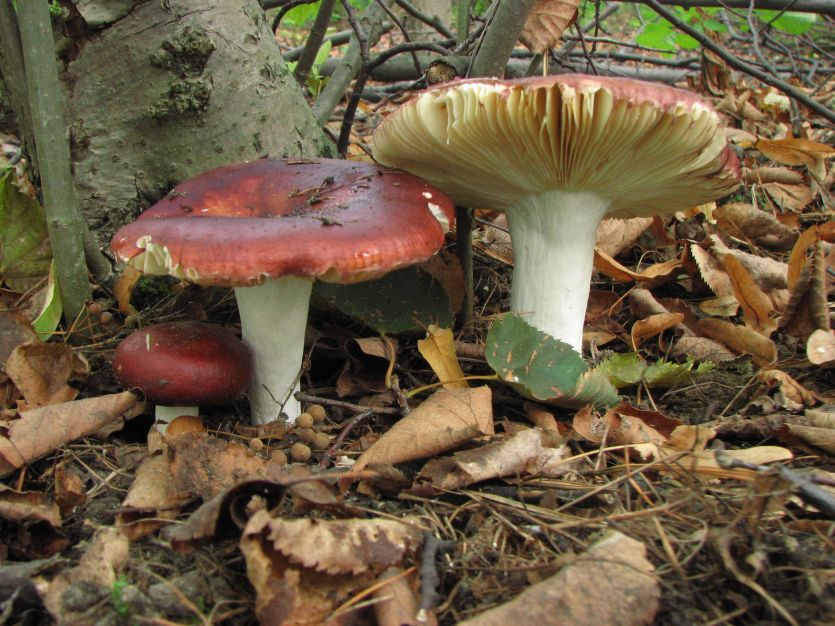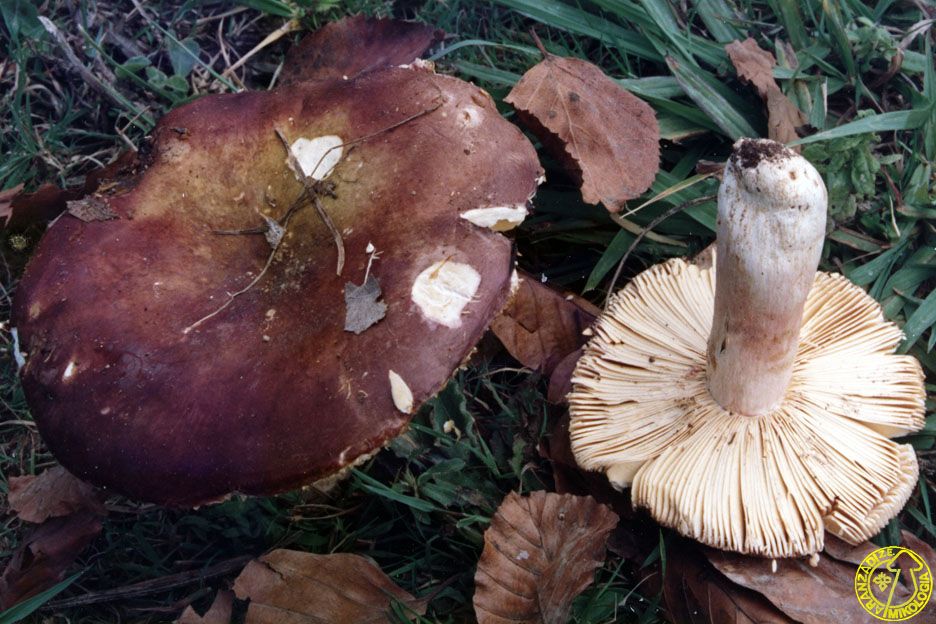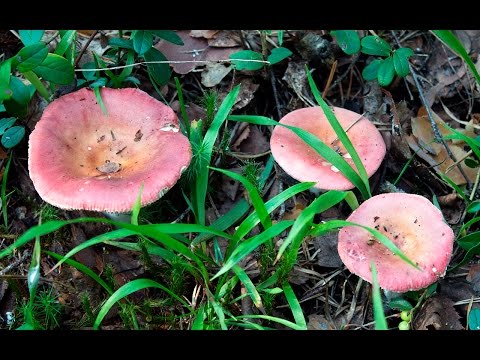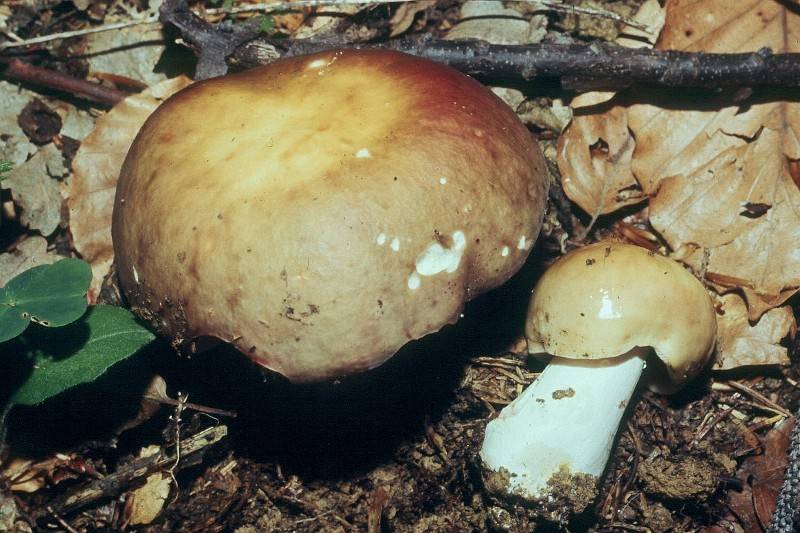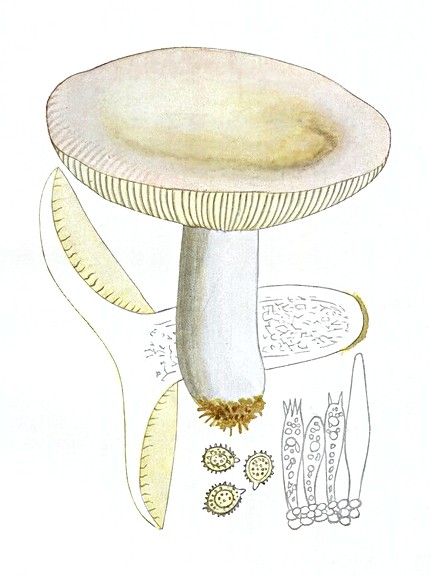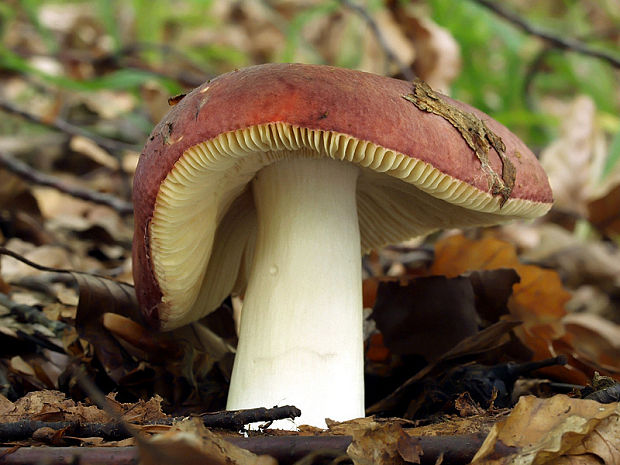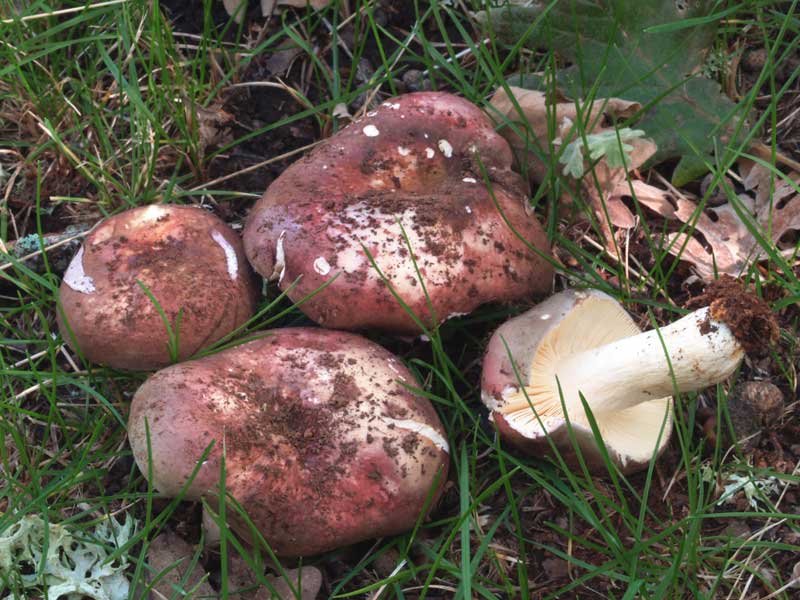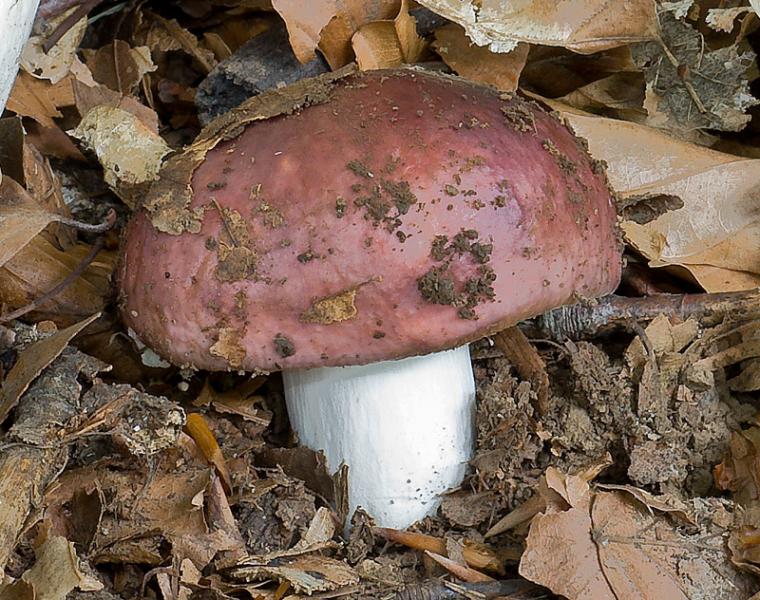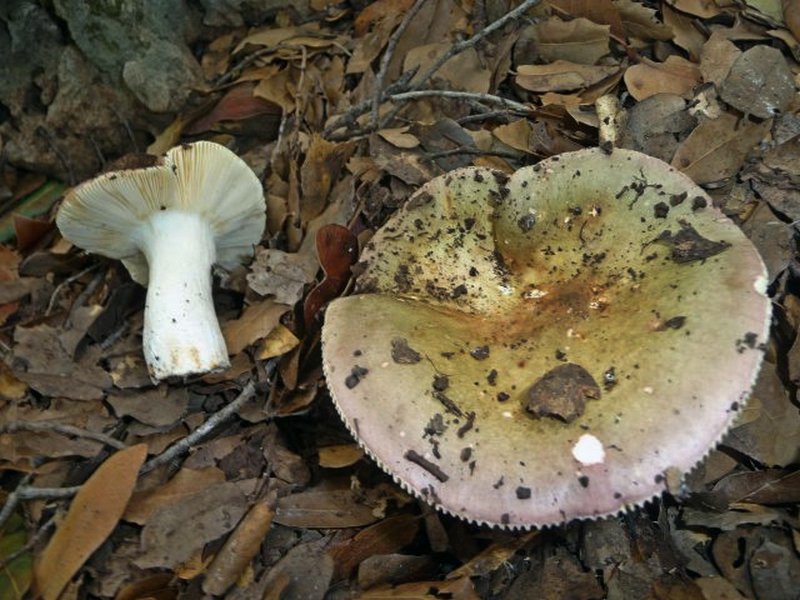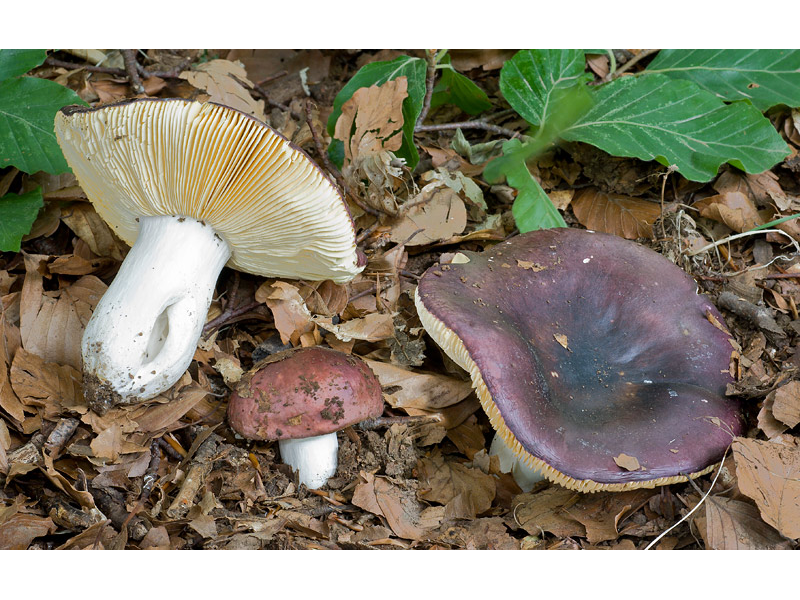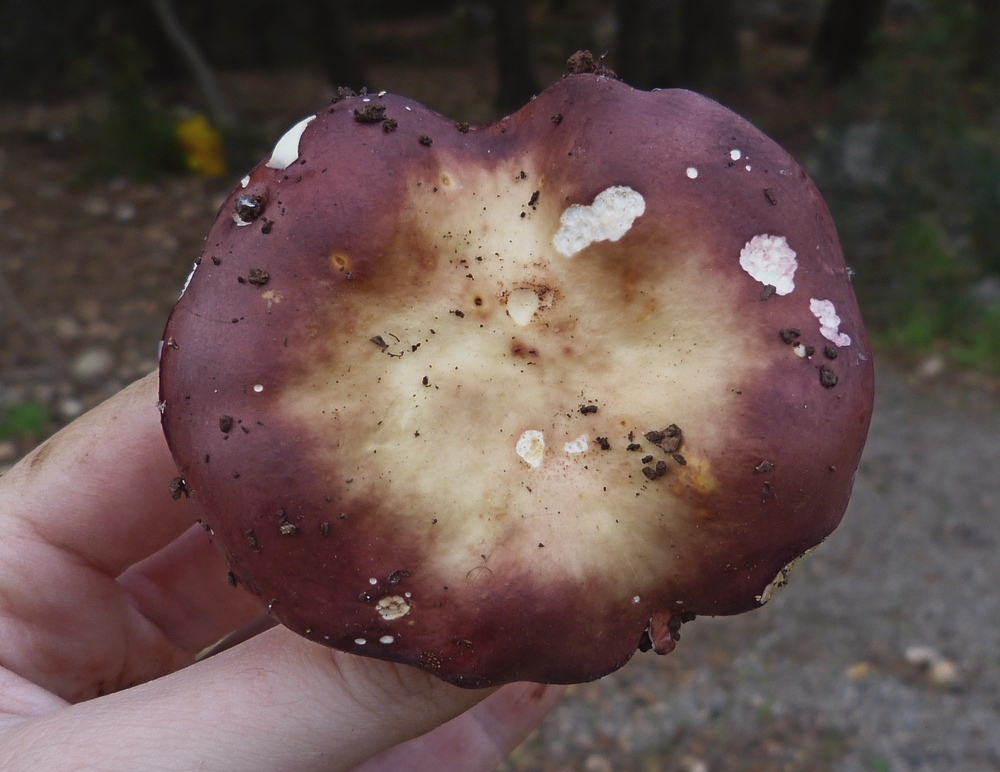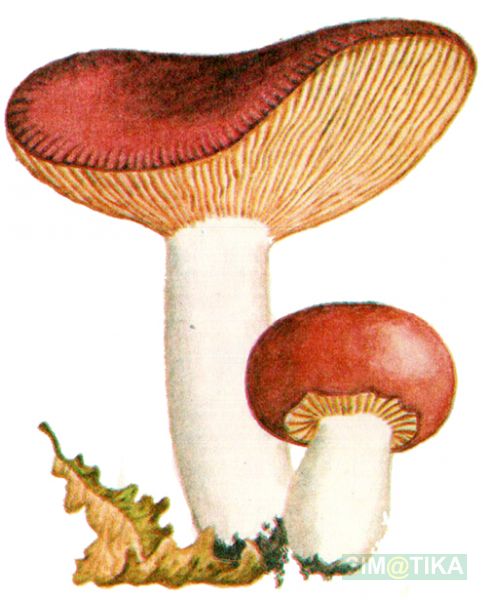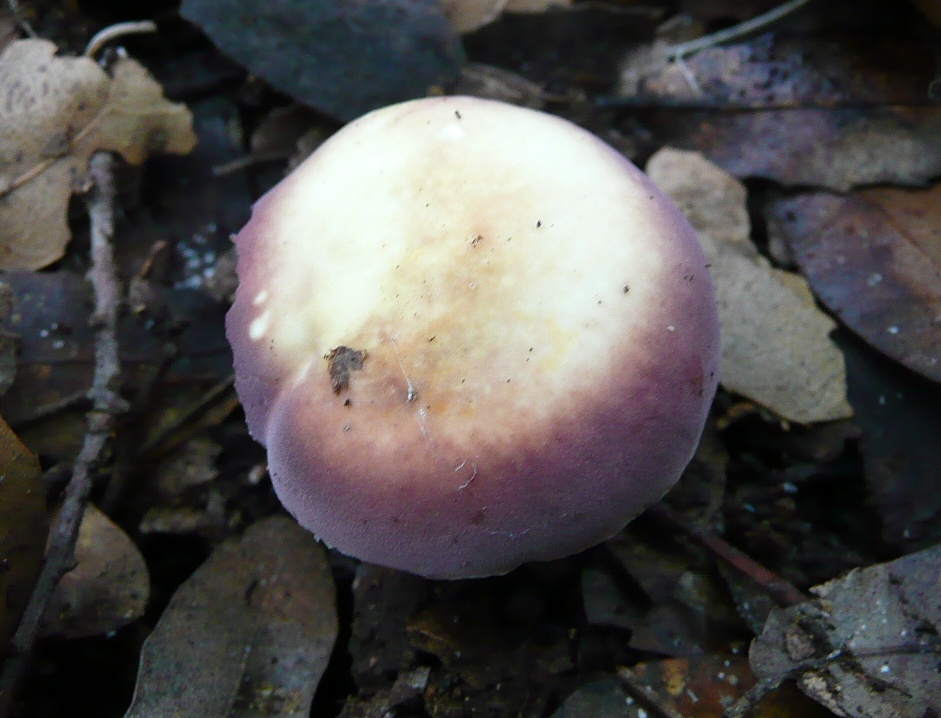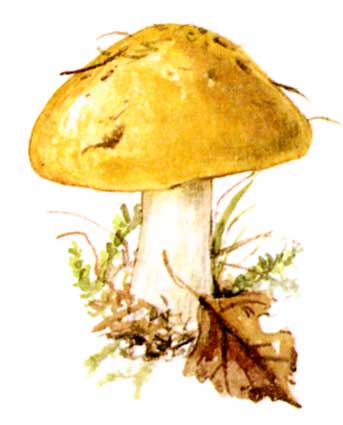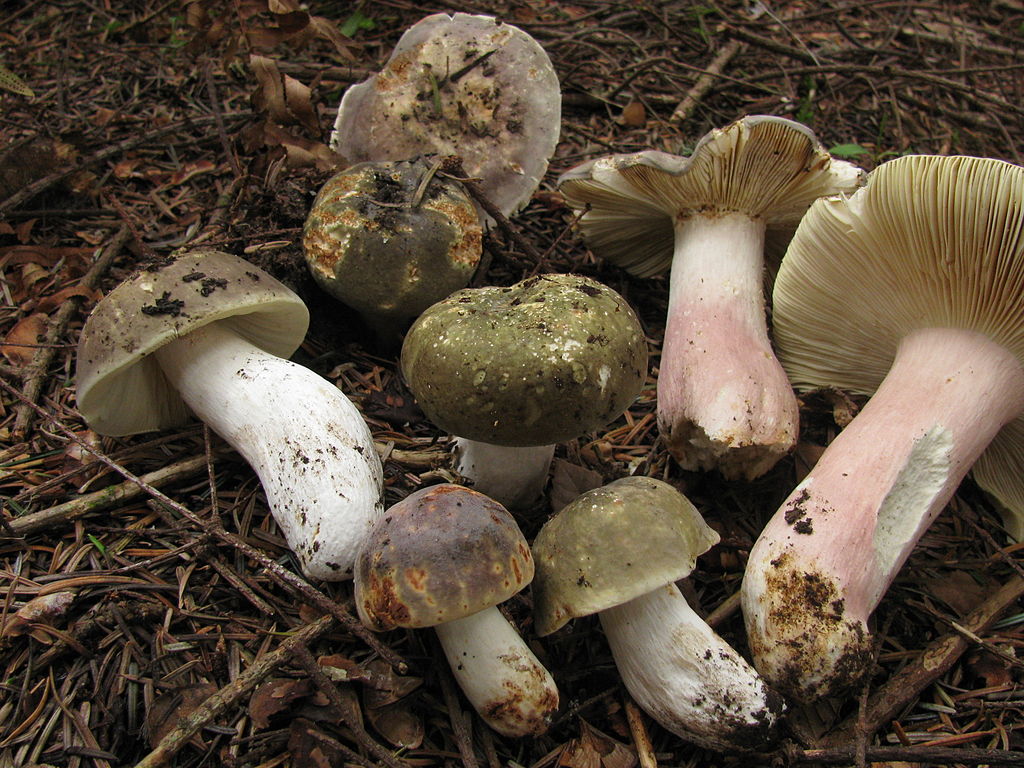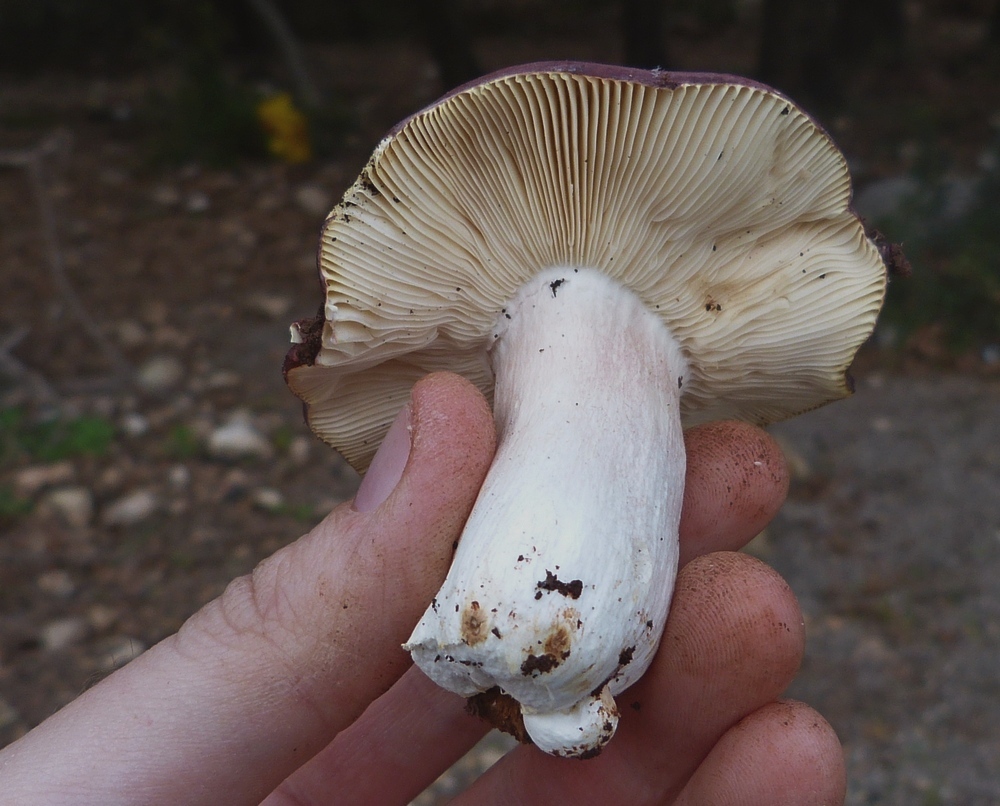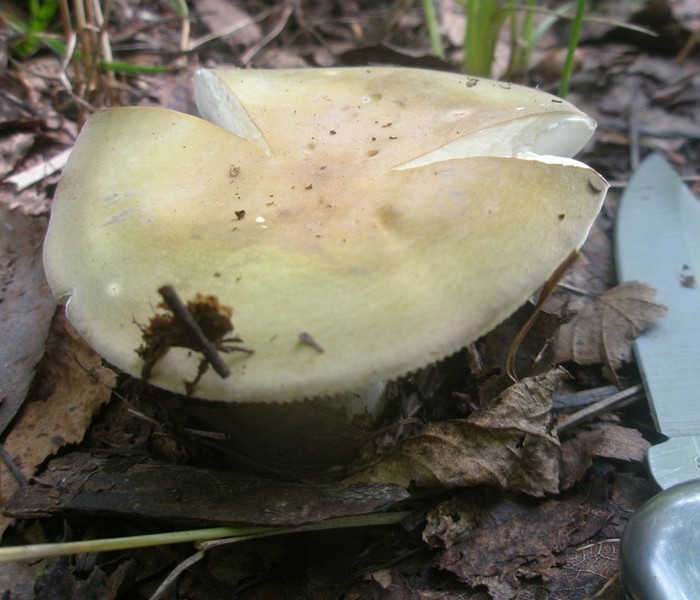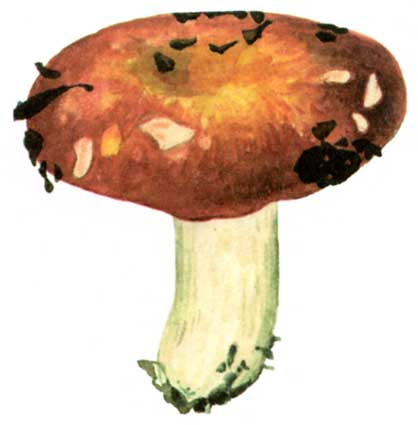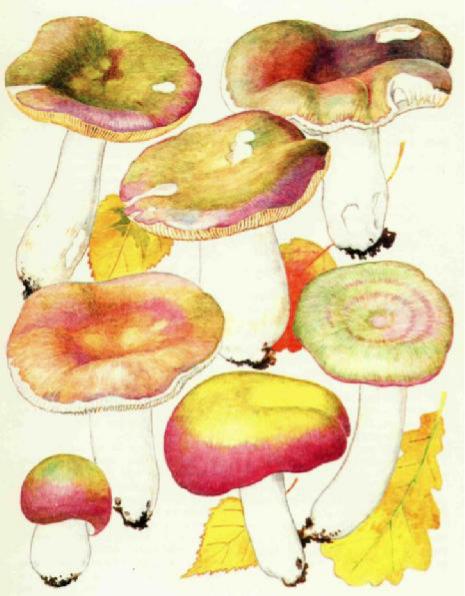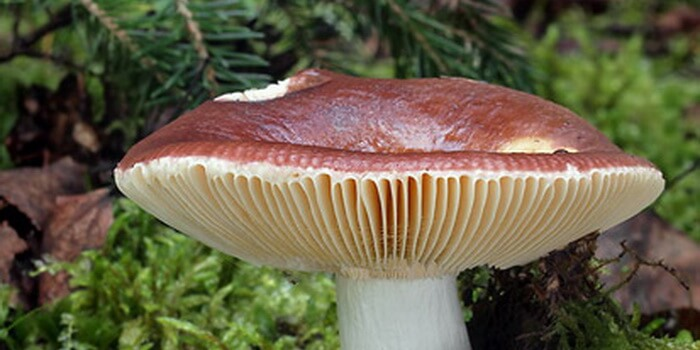Dangerous doubles of the green russula
Young pale toadstool looks very similar to this type of mushroom. Due to inexperience, mushroom pickers are gaining a poisonous crop and get light, medium and severe poisoning.

Pale toadstool - double of the green russula
When collecting green russula, be sure to pull the mushroom out of the ground, and do not cut it off with a knife. In lamellar mushrooms, the main difference lies in the stem. In the case of the toadstool, the velum forms a large thickening at the bottom of the stem. The russula has a straight leg without tubers.
In the pale toadstool, the leg is weakly scaly, in the russula it is even, white, streaky and without traces.
The toadstool has a white "skirt" under the cap, it breaks with age and remains either on the leg or along the edges of the cap. The green russula has no veils or "skirts" on the head / leg, the hymenophore is pure and white.
When removing the skin from the cap of the russula, the film remains in the center, the skin of the toadstool is removed to the very center.
Russula fading
| Group: | Lamellar |
|---|---|
| Plates: | White |
| Colour: | Crimson |
| Info: | On the cut turns red |
| Department: | Basidiomycota (Basidiomycetes) |
|---|---|
| Subdivision: | Agaricomycotina (Agaricomycetes) |
| Class: | Agaricomycetes (Agaricomycetes) |
| Subclass: | Incertae sedis (indefinite) |
| Order: | Russulales |
| Family: | Russulaceae (russula) |
| Genus: | Russula (Russula) |
| View: | Russula exalbicans (russula, fading) |
Description
The beautiful russula is characterized by a bright color of the cap, which "fades" over time, hence the name of the species.
Hat
Fading russula caps are usually small (up to 10 cm in diameter), but there are extremely large overripe specimens. The color is usually close to crimson, with darker edges. Enlightenment can be observed in the center. Small russules have spherical, gradually opening caps. The surface of the cap is dry and smooth. With the maturation of the mushroom and an increase in its size, the color of the cap turns pale. The skin is difficult to separate from the cap.
Leg
The leg of a beautiful russula is relatively thick and low (about 3 cm in thickness and 6 cm in length). It is cylindrical in shape with a downward extension. Its color is predominantly white with a pinkish tinge in the upper third. In the lower third, yellow spots may appear.
Pulp
In young specimens, the flesh is white, and in old specimens it is grayish, it turns red on the cut, then turns gray. The consistency is dense, tough, especially at the legs, so many people prefer to eat only hats. The raw mushroom tastes bitter, but when cooked it is sweetish.
Distribution and collection
The beautiful russula is widespread almost all over the world, but prefers temperate latitudes. Symbiotic coexistence is usually found in russules fading with deciduous trees. But the growth of this species is also possible in coniferous forests.
Similar species
The fading russula has a rather characteristic appearance so as not to be confused with other mushrooms. The only mushroom that looks a little like her is the russula, burning or emetic.
The latter is distinguished by whiter plates (not darkening in mature mushrooms) and pulp that does not gray out on the cut. This mushroom has a very bitter taste, therefore it is considered inedible.
Its use can cause stomach troubles, which reflects its name. However, according to some sources, russula emetic becomes edible when boiled well.
Edibility
The beautiful russula has, according to many consumers, very mediocre taste. The legs of these mushrooms are rarely eaten because of their rigidity. We can say that russula is an amateur mushroom, suitable for those who prefer a strong food consistency. After boiling, russula are fried with potatoes, salted and pickled.
Interesting facts
Russula mushrooms, including such as the fading russula, are characterized by a number of interesting properties:
- Russulin contained in russula promotes milk curdling, therefore russula components can be used in cheese making.
- Lecithin, which is part of this mushroom, lowers the content of bad cholesterol in the blood.
- Regular use of russula cleanses the gastrointestinal tract.
- The russula got its name not because it can be eaten raw. Quite the opposite: like any conditionally edible mushroom, it requires preliminary digestion.
And the name comes from the fact that pickles from these mushrooms are prepared faster than from the rest.
Not all mushroom pickers collect russules. Many neglect them, because there are boletus, moss and other, more "valuable" mushrooms. However, fried or salted russula are also quite edible and tasty.
The similarity of the green russula with other mushrooms
The russula has many counterparts. The most dangerous of them are fly agaric and pale toadstool. If a poisonous double gets into the mushroom picker basket, it is fraught with severe poisoning and death.
The developing russula bears some resemblance to the young toadstool. The leg and cap of these mushrooms are similar, but the presence of a volva, a ring and a characteristic unpleasant odor allows you to distinguish the poisonous fruit body. It is much easier to distinguish a ripe green russula, since its leg is clearly visible, which does not have a ring and a volva. In such a mushroom, the cap becomes depressed. In a pale toadstool, the cap remains convex even in adulthood.
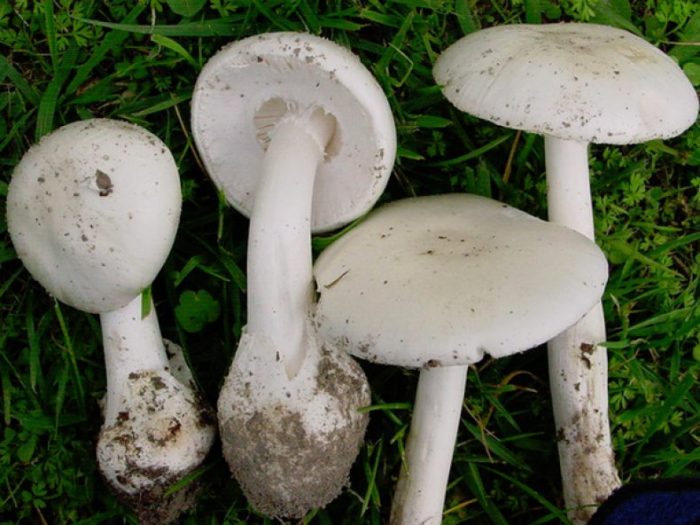 Russula is easy to confuse with poisonous pale toadstool.
Russula is easy to confuse with poisonous pale toadstool.
In addition, russula can be easily confused with fly agaric. Not all varieties of amanita are distinguished by a red or orange cap. Some of these dangerous mushrooms are gray-green in color. However, in the fly agaric, the growths present on the cap are easily peeled off, while in the russula, the scales, if any, grow so that they cannot be eliminated without severe damage to the cap.
Description of the green russula.
The cap of the green russula is not too fleshy. Its diameter reaches 14 centimeters. The surface of the cap is sticky. In dry weather, the hat shines and looks quite appetizing. The caps of young specimens have a pale greenish or whitish color, and by old age they become brown.
The spore-bearing layer in the green russula is represented by the lamellar type. In young fungi, the plates are white, and in overripe specimens, they are creamy. The plates are fragile, at first they are located quite often, then they diverge. They are almost free from the leg, sometimes branching next to it. The color of the spore powder is cream. The spores are warty, elliptical, with an indistinct mesh.
The leg is straight, cylindrical. She is quite thick - her girth can be up to 5 centimeters. The color of the leg is white, and with age, brownish spots appear on its surface.
The flesh of the green russula is strong. It tastes sweet, and almost no smell. The color of the pulp is at first white, and over time it becomes yellowish.
Places of growth of green russula.
Green russula can grow wherever there are forests. They inhabit deciduous and mixed forests. The Russian climate is the most favorable for this species, therefore the population of green russula is quite numerous.
Green russula bear fruit from July to October. They love cool weather, so they are most abundant in the fall. It is at this time that the harvest of green russula is most abundant. They grow in single specimens or in few groups.
Green russula are widespread in European mixed and deciduous forests. These mushrooms form mutually beneficial alliances (mycorrhiza) with downy birch and drooping birch.
Evaluation of the edibility of green russula.
Green russula belongs to the edible species of russula. It has a pleasant, not bitter taste.According to their taste, they are referred to the 4th category. This type of russula is the safest for consumption.
Green russula can be subjected to various types of culinary processing. They are suitable for frying, stewing, salting, pickling. This kind of russula can even be eaten raw.
The advantages of green russula and the rules for their collection.
Green russula, unlike many other russula, almost do not crumble during collection and tolerate transportation well, since they have a fairly dense structure, which is one of the main advantages of this species.
It is worth remembering that any mushrooms should be collected away from city limits and roads, as they absorb toxic substances and fumes from the air and soil.
The similarity of the green russula with other mushrooms.
It is easy to recognize this type of russula by the greenish tint of the cap. But beginners, nevertheless, can confuse the green russula with the pale toadstool. You can distinguish the pale toadstool by the ring on the leg, which the russula does not have.
Chemical composition of green russula.
Green russula is a dietary product - its calorie content is 19 kilocalories per 100 grams. They are composed of fats, proteins and carbohydrates. In addition, they are rich in minerals and vitamins. They contain vitamins PP, C, E, B1 and B2. They also contain minerals: Mg, Ca, K, P, Na and Fe.
How to distinguish russula from doubles
The russula are very diverse and are a very difficult genus in terms of identifying and limiting species. The differences between species are sometimes very small, making it difficult to identify these fungi. Accurate determination can be made using microscopic features as well as chemical reactions. When determining, it is necessary to have specimens of the same species at different stages of development.
Most russula are edible mushrooms, mainly of the 3rd and 4th categories. The economic value of russula is reduced due to the fragility of the fruit chalk. Few of them are poisonous, inedible, or of no practical value.
Both in appearance and in their structure, all types of russules are in general very similar: the caps of young mushrooms are completely spherical, becoming a little funnel-shaped by old age. Almost all russula have white, even legs, white dense flesh in young mushrooms, becomes fragile, brittle, crumbly with age. Even if you carefully put the russula in the basket, you still risk bringing home only mushroom crumbs, and only the young, with the hat still unopened, remain intact. For this brittle pulp, russula, in general, cannot be confused with any other mushrooms.
Russula in foliage.
The russula is burning.
Valuiform russules.
From the name of these mushrooms, it might seem like they can be eaten raw. In fact, everything is quite the opposite, raw these mushrooms are a terrible pungent bitterness, and the name "russula" can be translated as "raw pungency", so as not to try and try them. But in salting and during heat treatment, the acridity of russula completely disappears.
Most mushroom pickers do not distinguish russula by name at all. For them russula is russula: red, yellow, lilac, pink, green. So do not worry if you suddenly failed to determine the type of this or that russula: they are all edible. There are no poisonous russules among the russules, there are only inedible ones because of their bitter or unpleasant taste. The main thing is to be able to distinguish between such inedible species - but most of them are marked with a red leg or an unpleasant odor.
A stinging inedible russula.
There are also mushrooms in the russula family, which some mistakenly classify as mushrooms, calling them dry mushrooms. These are loads. Indeed, they have a weight-like appearance, not a russula: large, dense, with a short stem, with curled edges of funnel-shaped caps, with plates descending to the stem. But one cannot fail to notice their main difference from milk mushrooms - this is the complete absence of milky juice.Therefore, these mushrooms are popularly called dry mushrooms, that is, not weeping.
The flesh of the cap is mostly white or very light in color; thick or thin; odorless or with a faint aroma and a different taste. When the fruiting body of the russula breaks, the milky juice is not released. The plates, pulp and legs of russula are very fragile. Fragility and fragility of these mushrooms is given by spherocysts - special groups of vesicular cells that are found in the fruiting body.
Several types of russula are called podgruzki, but most often two: white podgruzdok (Russula delica) and black podgruzdok (Russula adusta). The fruiting body of these mushrooms is formed underground, and when the fungus appears on the surface of the soil, there is always a lot of adhering debris on its cap. Loads, even very young ones, are often wormy. They grow in large groups, they love humus-rich soil.
Spore coloration is an important sign of russula. When determining russula, it is necessary to determine the color of the spore powder macroscopically in the mass. The color of the powder in different species ranges between pure white and intense yellow, with various transitions and shades.
Description of wavy russula
It is a plastic mushroom. The cap in young specimens is bell-shaped or hemispherical; in the process of growth, the convex shape changes to an outstretched one, and reaches up to a depressed one, while the edges are bent. The diameter of the cap in mature specimens is 13-15 centimeters.
The characteristic color of the cap of young mushrooms is gray-green, later the shade becomes olive or purple with a black-purple or dark brown center. The cap is dense, smooth, fleshy. In young fruiting bodies, the surface of the cap is shiny, sticky, and in adults it becomes dull. The edges of the cap can be wavy or even. The skin can be removed by a third from the cap.
The plates are located often, their color is initially white, but over time they gradually turn yellow. Most often, the plates are wide, they can be either descending or free. The length of the plates is the same and different. The texture of the plate is brittle with pointed edges.
The leg of the russula is wavy, cylindrical, flat. Its height ranges from 4 to 10 cm, and its thickness is 1-3 cm. The color of the leg is white with a pinkish tinge in the upper part and yellow-brown at the base. In mature specimens, the legs turn gray and even brown.
The flesh of the black-purple russula is dense, especially in the leg. The color of the pulp is white, but when broken or cut, it has a characteristic pink tint, then it turns red, and then turns gray and can even turn black. The taste and smell of the pulp of young mushrooms is pungent, but the mature fruiting bodies have a sweetish taste and a pleasant fruity aroma. The wavy russula does not have milky juice. Spores are spiny, yellow-white in color, almost spherical in shape.
Growing places of black-purple russula
These mushrooms are found in coniferous and deciduous forests, among pines, oaks, beeches. They bear fruit from mid-August to October. They grow singly or in groups. They prefer mountainous or hilly terrain. They are found most often in humus under trees.
Edible russula wavy
Russula wavy is an edible mushroom of the 3rd category. It has a strong flesh, so it does not break when picked. Black-purple russula are suitable for cooking various hot and cold dishes, as well as for salting.
Dangerous resemblance
The edible wavy russula has a poisonous "twin" - the burning russula. These mushrooms are very similar in appearance, but the latter is very toxic. It is not for nothing that the stinging russula is called vomiting and nauseous, it causes gastrointestinal upset. There is evidence that these russules contain muscarine. Some mushroom pickers, nevertheless, use burning russules for food, for this they pre-boil them for 20 minutes and wash them.
The cap of the stinging russula is at first convex, and over time it becomes more and more open, and as a result, completely depressed. The edges of older specimens are ribbed. Coloring from bright red to pinkish with ocher and white spots. The leg is cylindrical, hollow, strong.
Scorching russula quite often grow on peat bogs in various places. Also found in deciduous forests, less commonly grow in coniferous forests. These mushrooms love mountainous terrain. They bear fruit from July to October.
Taste characteristics of golden-red russula
Russula golden-red rather tasty mushrooms. Their taste is a little sweet, and they have no smell.
Other mushrooms of this genus
Morse russula is an edible mushroom. The diameter of the cap reaches 12 centimeters. In young specimens, the caps look like balls, after which they become bell-shaped, and even later become flat. The cap is covered with dry skin, which easily separates from the pulp. The color of the cap is yellow-brown. The leg is dense, white in color, sometimes with spots. Most often, the legs are straight, but sometimes they can be thickened in the lower part.
Russula are often found in the forests of Russia. It is this species that accounts for about 47% of all other mushrooms. Mostly Morse russules are salted, as they are quite bitter. They must be soaked and the skin removed from the cap.
Brittle russula is a conditionally edible mushroom. This is a small russula, the diameter of the cap of which is 2.5-6 cm. Its color is most often pink-purple. Its shape is first convex, and then it opens and reaches concave. Short scars are visible along the edge of the cap. The leg is cylindrical, smooth, mealy, white.
There are often brittle russula. They grow in mixed, coniferous and deciduous forests. They prefer to settle on acidic soils. They can be found under pine, birch, hornbeam, oak, and other trees. Brittle russula bear fruit from August to October, in good years they are found already in June. These mushrooms grow in the European part of our country, in Karelia, Belarus, the Baltic States and Ukraine.
In terms of taste, russula brittle are referred to the 4th category. They are eaten exclusively in salty form, and raw russula brittle can provoke a mild gastrointestinal upset.
Edible green-red russula
Green-red russula is an edible mushroom, according to its taste, it belongs to the 3rd category. Green-red russula can be boiled and salted.
Other mushrooms of this genus
• Almond russula or cherry laurel - edible mushroom. The color of the cap is changeable - initially it is ocher-yellow, but with age it becomes brown-honey. The leg is light at the top, at the bottom of brown shades. These mushrooms grow in summer and autumn, settle in deciduous and mixed forests.
• Brittle russula - conditionally edible mushroom. Its color is pink-purple, with age it becomes less saturated. These fungi prefer acidic soils. They grow in different types of forests, next to oaks, hornbeams, birches and pines. In terms of taste, these mushrooms belong to the 4th category, they are eaten only in salted form. Raw specimens can cause poisoning.
• Yellow russula - edible mushroom. This mushroom has an intense yellow cap. Yellow russula can be eaten salted or raw.

• Beautiful russula - conditionally edible mushroom. The flesh of the cap is thick, bright red in color, it fades over time. The leg is white in color, may have a pink tint. Most often, these mushrooms are found in deciduous forests, next to beeches, but they do not like coniferous plantations. Beautiful russula bear fruit in summer and autumn;
• Russula scaly or greenish characterized by a gray-green or green color of the cap. The leg is white, with a spicy nutty flavor. These edible mushrooms are harvested from summer to autumn. They grow mainly in deciduous forests.
• Morse russula - edible mushroom.These mushrooms are quite numerous, they make up 45-47% of the total yield. Their cap is yellow or yellow-brown in color, and the leg is white. Remove the skin from the cap before cooking because it tastes bitter.

Birch russula (Russula betularum)
Other names:
Russula emetica
Birch russula (Russula emetica) is a mushroom belonging to the russula family and russula genus.
External description
Birch russula (Russula emetica) is a fleshy fruiting body, consisting of a cap and a leg, the flesh of which is white and very fragile. At high humidity, it changes its color to grayish, has a faint smell and a pungent taste.
The head of the mushroom reaches 2-5 cm in diameter, is characterized by a large thickness, but at the same time it is very fragile. In immature fruiting bodies, it is flattened and has wavy edges. As the mushroom matures, it becomes slightly depressed. Its color can be very varied, from deep red to copper. True, more often the hat of birch russules is lilac-pink, with a yellowish tint in the center. At high air humidity, it can become mottled, changing its color to cream. The top skin is very easy to remove from the cap.
The leg of birch russula is initially characterized by a high density, but in wet weather it becomes very brittle and becomes very wet. Its thickness along its entire length is approximately the same, but sometimes it is thinner at the top. The leg of birch russula has a yellowish or white color, wrinkled, inside it is often empty (especially in ripe fruit bodies).
The fungus hymenophore is lamellar, consists of thin, rare and fragile plates, slightly growing together with the surface of the leg. Are white and have jagged edges. The spore powder is also white, consists of small ovoid particles that form an incomplete network.
Season and habitat of the mushroom
The described species is widespread in Northern Europe. Birch russula got their name for their growth in birch forests. In addition, mushrooms of this species can also be found in mixed coniferous-deciduous forests, where many birches grow. Birch russula like to grow in humid places, sometimes found in swampy areas, on sphagnum. The birch russula mushroom is widespread in Russia, Belarus, Great Britain, European countries, Ukraine, Scandinavia. Active fruiting begins in mid-summer and continues until the end of the first half of autumn.
Edibility
Birch russula (Russula betularum) belongs to the category of conditionally edible mushrooms, but some mycologists classify it as inedible. Fresh consumption of this type of mushroom can lead to mild gastrointestinal poisoning. True, this effect is caused by the use of the fruiting bodies of the fungus together with the upper film, which contains toxic substances. If you remove it before eating mushrooms, then they will not be poisoned.
Related species
In nature, there are many varieties of these mushrooms. Often in the forests there is a stinging russula, which is classified as conditionally edible. These mushrooms are distinguished by the presence of a light red convex cap. The stem and plates are pinkish-beige in color. Due to this color, this variety is difficult to confuse with green. The pulp is soft and fragile. She is white. Often, mushroom pickers put it in a basket, mistakenly considering it a fibrous or food variety of the mushroom.
Burning russula has an extremely unpleasant taste and light fruity aroma. This type requires long-term heat treatment. It removes bitterness. This variety cannot be eaten raw, since the pulp contains muscarine, which is the strongest toxin that can provoke severe poisoning in humans. After prolonged heat treatment, some of the toxic substances disintegrate, so the fruit can be eaten in small quantities.
 The stinging russula has a light red cap.
The stinging russula has a light red cap.
Another common member of the family is the spicy russula. It is found more often in coniferous forests, because able to enter into symbiosis with pine. This fruit has a neat cap, reaching 3-7 cm in diameter, characterized by a cherry color. The pulp has a light fruity aroma. She is white. The taste is pungent. The peel does not come off well. The leg is pink-lilac in color. This variety contains muscarine and therefore requires long-term heat treatment. The mushroom is conditionally edible.
In deciduous and coniferous forests, blood-red russula is also often found. The hat reaches 10 cm in diameter. At first, it has a convex shape, and then becomes like a disk. Its surface is deep red. The peel does not come off well. The pulp is white and firm. The mushroom should not be eaten raw, since it has an unpleasant bitter taste. Without heat treatment, this variety can provoke indigestion. After prolonged cooking, the pulp becomes ready to eat.
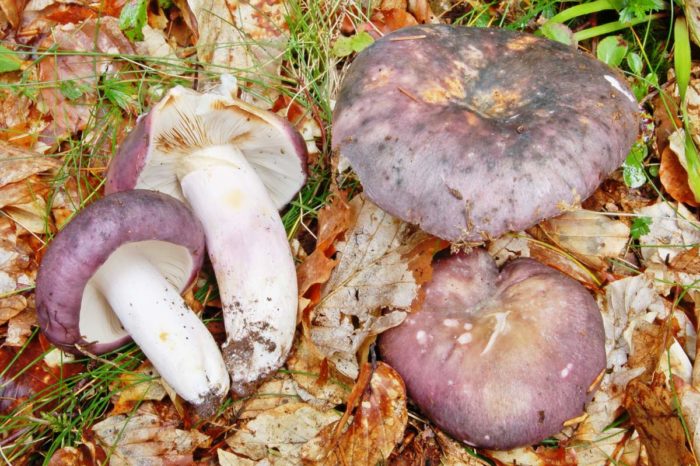 The blue-yellow russula is found in both deciduous and coniferous forests
The blue-yellow russula is found in both deciduous and coniferous forests
Edible mushrooms include the blue-yellow russula. The color of her cap ranges from gray-green to purple. It has a semicircular or flat shape. The leg is distinguished by the shape of a cylinder. Its surface is slightly wrinkled. The pulp is fragile and juicy. It has a pleasant nutty flavor. This species is found in both deciduous and coniferous forests.
Another edible related species is the graying russula. The cap color ranges from reddish-orange to yellow-brown. The peel is difficult to remove. The leg has a dense structure. In a mature fruit, it is gray. The pulp is white and has a pleasant sweetish taste and mushroom aroma. This type of russula is found mainly in pine forests.

